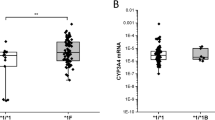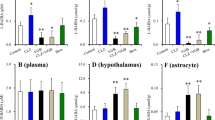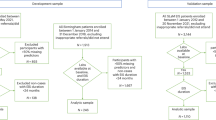Abstract
Antipsychotic drugs are currently used in clinical practice for a variety of mental disorders. Among them, clozapine is the most effective medication for treatment-resistant schizophrenia and is most helpful in controlling aggression and the suicidal behavior in schizophrenia and schizoaffective disorder. Although clozapine is associated with a low likelihood of extrapyramidal symptoms and other neurological side effects, it is well known for the weight gain and metabolic side effects, which expose the patient to a greater risk of cardiovascular disorders and premature death, as well as psychosocial issues, leading to non-adherence to therapy. The mechanisms underlying these iatrogenic metabolic disorders are still controversial. We have therefore investigated the in vivo effects of the selective PKCβ inhibitor, ruboxistaurin (LY-333531), in a preclinical model of long-term clozapine-induced weight gain. Cell biology, biochemistry, and behavioral tests have been performed in wild-type and PKCβ knockout mice to investigate the contribution of endogenous PKCβ and its pharmacological inhibition to the psychomotor effects of clozapine. Finally, we also shed light on a novel aspect of the mechanism underlying the clozapine-induced weight gain, demonstrating that the clozapine-dependent PKCβ activation promotes the inhibition of the lipid droplet-selective autophagy process. This paves the way to new therapeutic approaches to this serious complication of clozapine therapy.
Similar content being viewed by others
Log in or create a free account to read this content
Gain free access to this article, as well as selected content from this journal and more on nature.com
or
References
Abu-Elheiga L, Matzuk MM, Abo-Hashema KA, Wakil SJ (2001). Continuous fatty acid oxidation and reduced fat storage in mice lacking acetyl-CoA carboxylase 2. Science 291: 2613–2616.
Aguiari P, Leo S, Zavan B, Vindigni V, Rimessi A, Bianchi K et al (2008). High glucose induces adipogenic differentiation of muscle-derived stem cells. Proc Natl Acad Sci USA 105: 1226–1231.
Bansode RR, Huang W, Roy SK, Mehta M, Mehta KD (2008). Protein kinase C deficiency increases fatty acid oxidation and reduces fat storage. J Biol Chem 283: 231–236.
Bononi A, Agnoletto C, De Marchi E, Marchi S, Patergnani S, Bonora M et al (2011). Protein kinases and phosphatases in the control of cell fate. Enzyme Res 2011: 329098.
Brasaemle DL, Rubin B, Harten IA, Gruia-Gray J, Kimmel AR, Londos C (2000). Perilipin A increases triacylglycerol storage by decreasing the rate of triacylglycerol hydrolysis. J Biol Chem 275: 38486–38493.
Brini M, De Giorgi F, Murgia M, Marsault R, Massimino ML, Cantini M et al (1997). Subcellular analysis of Ca2+ homeostasis in primary cultures of skeletal muscle myotubes. Mol Biol Cell 8: 129–143.
Caemmerer J, Correll CU, Maayan L (2012). Acute and maintenance effects of non-pharmacologic interventions for antipsychotic associated weight gain and metabolic abnormalities: a meta-analytic comparison of randomized controlled trials. Schizophr Res 140: 159–168.
Citrome L, Vreeland B (2008). Schizophrenia, obesity, and antipsychotic medications: what can we do? Postgrad Med 120: 18–33.
Danis RP, Bingaman DP, Jirousek M, Yang Y (1998). Inhibition of intraocular neovascularization caused by retinal ischemia in pigs by PKCbeta inhibition with LY333531. Invest Ophthalmol Vis Sci 39: 171–179.
Deissler HL, Lang GE (2016). The protein kinase C inhibitor: ruboxistaurin. Dev Ophthalmol 55: 295–301.
Deng C (2013). Effects of antipsychotic medications on appetite, weight, and insulin resistance. Endocrinol Metab Clin North Am 42: 545–563.
Denizot F, Lang R (1986). Rapid colorimetric assay for cell growth and survival. Modifications to the tetrazolium dye procedure giving improved sensitivity and reliability. J Immunol Methods 89: 271–277.
Foley DL, Morley KI (2011). Systematic review of early cardiometabolic outcomes of the first treated episode of psychosis. Arch Gen Psychiatry 68: 609–616.
Frogley C, Taylor D, Dickens G, Picchioni M (2012). A systematic review of the evidence of clozapine's anti-aggressive effects. Int J Neuropsychopharmacol 15: 1351–1371.
Galluzzi L, Pietrocola F, Levine B, Kroemer G (2014). Metabolic control of autophagy. Cell 159: 1263–1276.
Giorgi C, Agnoletto C, Baldini C, Bononi A, Bonora M, Marchi S et al (2010). Redox control of protein kinase C: cell- and disease-specific aspects. Antioxid Redox Signal 13: 1051–1085.
Hagg S, Soderberg S, Ahren B, Olsson T, Mjorndal T (2001). Leptin concentrations are increased in subjects treated with clozapine or conventional antipsychotics. J Clin Psychiatry 62: 843–848.
Hartfield AW, Moore NA, Clifton PG (2003). Effects of clozapine, olanzapine and haloperidol on the microstructure of ingestive behaviour in the rat. Psychopharmacology 167: 115–122.
Hemmrich K, Gummersbach C, Pallua N, Luckhaus C, Fehsel K (2006). Clozapine enhances differentiation of adipocyte progenitor cells. Mol Psychiatry 11: 980–981.
Henderson DC, Sharma B, Fan X, Copeland PM, Borba CP, Freudenreich O et al (2010). Dietary saturated fat intake and glucose metabolism impairments in nondiabetic, nonobese patients with schizophrenia on clozapine or risperidone. Ann Clin Psychiatry 22: 33–42.
Huang W, Bansode R, Mehta M, Mehta KD (2009). Loss of protein kinase Cbeta function protects mice against diet-induced obesity and development of hepatic steatosis and insulin resistance. Hepatology 49: 1525–1536.
Inoguchi T, Battan R, Handler E, Sportsman JR, Heath W, King GL (1992). Preferential elevation of protein kinase C isoform beta II and diacylglycerol levels in the aorta and heart of diabetic rats: differential reversibility to glycemic control by islet cell transplantation. Proc Natl Acad Sci USA 89: 11059–11063.
Ishii H, Jirousek MR, Koya D, Takagi C, Xia P, Clermont A et al (1996). Amelioration of vascular dysfunctions in diabetic rats by an oral PKC beta inhibitor. Science 272: 728–731.
Klionsky DJ, Abdelmohsen K, Abe A, Abedin MJ, Abeliovich H (2016). Guidelines for the use and interpretation of assays for monitoring autophagy (3rd edition). Autophagy 12: 1–222.
Kluge M, Schuld A, Himmerich H, Dalal M, Schacht A, Wehmeier PM et al (2007). Clozapine and olanzapine are associated with food craving and binge eating: results from a randomized double-blindstudy. J Clin Psychopharmacol 27: 662–666.
Legge SE, Hamshere M, Hayes RD, Downs J, O'Donovan MC, Owen MJ et al (2016). Reasons for discontinuing clozapine: a cohort study of patients commencing treatment. Schizophr Res 174: 113–119.
Lei S, Li H, Xu J, Liu Y, Gao X, Wang J et al (2013). Hyperglycemia-induced protein kinase C beta2 activation induces diastolic cardiac dysfunction in diabetic rats by impairing caveolin-3 expression and Akt/eNOS signaling. Diabetes 62: 2318–2328.
Leucht S, Corves C, Arbter D, Engel RR, Li C, Davis JM (2009). Second-generation versus first-generation antipsychotic drugs for schizophrenia: a meta-analysis. Lancet 373: 31–41.
Liu M, Liu F (2010). Transcriptional and post-translational regulation of adiponectin. Biochem J 425: 41–52.
Longatti A, Lamb CA, Razi M, Yoshimura S, Barr FA, Tooze SA (2012). TBC1D14 regulates autophagosome formation via Rab11- and ULK1-positive recycling endosomes. J Cell Biol 197: 659–675.
Maayan L, Vakhrusheva J, Correll CU (2010). Effectiveness of medications used to attenuate antipsychotic-related weight gain and metabolic abnormalities: a systematic review and meta-analysis. Neuropsychopharmacology 35: 1520–1530.
Mamo DC (2007). Managing suicidality in schizophrenia. Can J Psychiatry 52 (Suppl 1): 59S–70S.
Marti M, Trapella C, Viaro R, Morari M (2007). The nociceptin/orphanin FQ receptor antagonist J-113397 and L-DOPA additively attenuate experimental parkinsonism through overinhibition of the nigrothalamic pathway. J Neurosci 27: 1297–1307.
Meltzer HY (2012). Clozapine: balancing safety with superior antipsychotic efficacy. Clin Schizophr Relat Psychoses 6: 134–144.
Nagareddy PR, Soliman H, Lin G, Rajput PS, Kumar U, McNeill JH et al (2009). Selective inhibition of protein kinase C beta(2) attenuates inducible nitric oxide synthase-mediated cardiovascular abnormalities in streptozotocin-induced diabetic rats. Diabetes 58: 2355–2364.
O'Rourke EJ, Ruvkun G (2013). MXL-3 and HLH-30 transcriptionally link lipolysis and autophagy to nutrient availability. Nat Cell Biol 15: 668–676.
Patergnani S, Marchi S, Rimessi A, Bonora M, Giorgi C, Mehta KD et al (2013). PRKCB/protein kinase C, beta and the mitochondrial axis as key regulators of autophagy. Autophagy 9: 1367–1385.
Pavan C, Vindigni V, Michelotto L, Rimessi A, Abatangelo G, Cortivo R et al (2010). Weight gain related to treatment with atypical antipsychotics is due to activation of PKC-β. Pharmacogenomics J 10: 408–417.
Pinton P, Pavan C, Zavan B (2011). PKC-beta activation and pharmacologically induced weight gain during antipsychotic treatment. Pharmacogenomics 12: 453–455.
Rimessi A, Bonora M, Marchi S, Patergnani S, Marobbio CM, Lasorsa FM et al (2013). Perturbed mitochondrial Ca2+ signals as causes or consequences of mitophagy induction. Autophagy 9: 1677–1686.
Rimessi A, Rizzuto R, Pinton P (2007). Differential recruitment of PKC isoforms in HeLa cells during redox stress. Cell Stress Chaperones 12: 291–298.
Saha S, Chant D, McGrath J (2007). A systematic review of mortality in schizophrenia: is the differential mortality gap worsening over time? Arch Gen Psychiatry 64: 1123–1131.
Schallert T, De Ryck M, Whishaw IQ, Ramirez VD, Teitelbaum P (1979). Excessive bracing reactions and their control by atropine and L-DOPA in an animal analog of Parkinsonism. Exp Neurol 64: 33–43.
Settembre C, De Cegli R, Mansueto G, Saha PK, Vetrini F, Visvikis O et al (2013). TFEB controls cellular lipid metabolism through a starvation-induced autoregulatory loop. Nat Cell Biol 15: 647–658.
Seufert J, Kieffer TJ, Leech CA, Holz GG, Moritz W, Ricordi C et al (1999). Leptin suppression of insulin secretion and gene expression in human pancreatic islets: implications for the development of adipogenic diabetes mellitus. J Clin Endocrinol Metab 84: 670–676.
Sinclair D, Adams CE (2014). Treatment resistant schizophrenia: a comprehensive survey of randomised controlled trials. BMC Psychiatry 14: 253.
Singh R, Kaushik S, Wang Y, Xiang Y, Novak I, Komatsu M et al (2009). Autophagy regulates lipid metabolism. Nature 458: 1131–1135.
Siskind DJ, Leung J, Russell AW, Wysoczanski D, Kisely S (2016). Metformin for clozapine associated obesity: a systematic review and meta-analysis. PLoS ONE 11: e0156208.
Skinner JR, Harris LA, Shew TM, Abumrad NA, Wolins NE (2013). Perilipin 1 moves between the fat droplet and the endoplasmic reticulum. Adipocyte 2: 80–86.
Stahl SM, Mignon L, Meyer JM (2009). Which comes first: atypical antipsychotic treatment or cardiometabolic risk? Acta Psychiatr Scand 119: 171–179.
Stockli J, Meoli CC, Hoffman NJ, Fazakerley DJ, Pant H, Cleasby ME et al (2015). The RabGAP TBC1D1 plays a central role in exercise-regulated glucose metabolism in skeletal muscle. Diabetes 64: 1914–1922.
Stone S, Abkevich V, Russell DL, Riley R, Timms K, Tran T et al (2006). TBC1D1 is a candidate for a severe obesity gene and evidence for a gene/gene interaction in obesity predisposition. Hum Mol Genet 15: 2709–2720.
Szekeres F, Chadt A, Tom RZ, Deshmukh AS, Chibalin AV, Bjornholm M et al (2012). The Rab-GTPase-activating protein TBC1D1 regulates skeletal muscle glucose metabolism. Am J Physiol Endocrinol Metab 303: E524–E533.
Viaro R, Sanchez-Pernaute R, Marti M, Trapella C, Isacson O, Morari M (2008). Nociceptin/orphanin FQ receptor blockade attenuates MPTP-induced parkinsonism. Neurobiol Dis 30: 430–438.
Wang J, Liu R, Hawkins M, Barzilai N, Rossetti L (1998). A nutrient-sensing pathway regulates leptin gene expression in muscle and fat. Nature 393: 684–688.
Wolsk E, Mygind H, Grondahl TS, Pedersen BK, van Hall G (2012). Human skeletal muscle releases leptin in vivo. Cytokine 60: 667–673.
Zhang Y, Guo KY, Diaz PA, Heo M, Leibel RL (2002). Determinants of leptin gene expression in fat depots of lean mice. Am J Physiol Regul Integr Compar Physiol 282: R226–R234.
Author information
Authors and Affiliations
Corresponding author
Additional information
Supplementary Information accompanies the paper on the Neuropsychopharmacology website
Rights and permissions
About this article
Cite this article
Rimessi, A., Pavan, C., Ioannidi, E. et al. Protein Kinase C β: a New Target Therapy to Prevent the Long-Term Atypical Antipsychotic-Induced Weight Gain. Neuropsychopharmacol 42, 1491–1501 (2017). https://doi.org/10.1038/npp.2017.20
Received:
Revised:
Accepted:
Published:
Issue date:
DOI: https://doi.org/10.1038/npp.2017.20
This article is cited by
-
A protein kinase C α and β inhibitor blunts hyperphagia to halt renal function decline and reduces adiposity in a rat model of obesity-driven type 2 diabetes
Scientific Reports (2023)
-
Linking Inflammation, Aberrant Glutamate-Dopamine Interaction, and Post-synaptic Changes: Translational Relevance for Schizophrenia and Antipsychotic Treatment: a Systematic Review
Molecular Neurobiology (2022)
-
Drugs Affecting Body Weight, Body Fat Distribution, and Metabolic Function—Mechanisms and Possible Therapeutic or Preventive Measures: an Update
Current Obesity Reports (2021)
-
Pulsed electromagnetic fields increase osteogenetic commitment of MSCs via the mTOR pathway in TNF-α mediated inflammatory conditions: an in-vitro study
Scientific Reports (2018)
-
Drug-induced obesity and its metabolic consequences: a review with a focus on mechanisms and possible therapeutic options
Journal of Endocrinological Investigation (2017)



